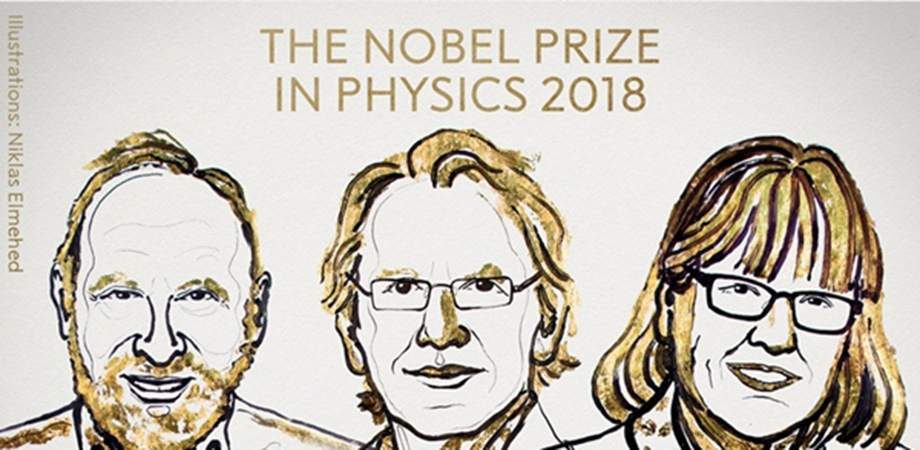"This year's prize is about tools made from light," said the Royal Swedish Academy of Sciences in Stockholm in its announcement of the 2018 Nobel Prize for Physics.
The prize has been awarded to three laser physicists, marking the second consecutive year that photonics-related work has been recognized by the Nobel committee.
The 2017 Nobel Prize for Physics was awarded to three of the key scientists involved in the first direct observation of gravitational waves. In 2014, the Nobel Prize for Physics went to three inventors of blue LEDs and laser diodes, while the Nobel Prize for Chemistry was awarded to three pioneers in super-resolution microscopy, using lasers and photonics techniques.
Half of this year's physics prize was awarded to Arthur Ashkin, who pioneered the early development of optical tweezers while at Bell Laboratories. Optical tweezers are light beams that can manipulate tiny organisms such as bacteria without damaging them. The other half of the prize is shared by Gérard Mourou and Donna Strickland, who invented the chirped-pulse amplification (CPA) technique for producing high-energy, ultrashort laser pulses while at the University of Rochester.
"With this year's announcement, we now have a dozen physics Nobel prizes that advanced, or were enabled by, optics and photonics since the invention of the laser," says SPIE CEO Kent Rochford. "Congratulations to Arthur Ashkin, a laser pioneer whose development of optical tweezers paved the way for laser trapping and cooling techniques that have advanced our understanding and control of quantum mechanical effects that underpin the "second quantum revolution" underway today. And congratulations to Gérard Mourou and Donna Strickland, whose groundbreaking co-invention of a chirped pulse amplification overcame the limitations of self-focusing and enabled the highest-power lasers in existence today, creating new probes for the study of ultrafast phenomena as well as practical applications."
Strickland, now at University of Waterloo in Canada, is the first woman to be awarded the physics prize since Maria Goeppert-Mayer in 1963 and Marie Curie in 1903. (Curie won the Nobel Prize for Chemistry in 1911.)
"Is that all? I thought there might have been more," said Strickland when asked how it felt to be the third woman in history to win the prize. "Obviously, we need to celebrate women physicists, because we're out there. I'm honored to be one of those women."
Mourou, of École Polytechnique in France and the University of Michigan, has been closely involved in the design and construction of the ELI facilities, which are among many giant laser facilities using CPA.
After developing CPA with Strickland, Mourou became founding director of the Center for Ultrafast Optical Science (CUOS) in Michigan - an institution that currently houses the 300 terawatt-pulsed HERCULES laser, based on the CPA technique. In 1997, Mourou received the SPIE Harold E. Edgerton Award in High-Speed Optics.
At age 96, Ashkin is the oldest person to be awarded the Nobel Prize. According to a comment from the Nobel committee on Tuesday morning, Ashkin would not be available for interviews, because he is "too busy working on his next paper."
"As scientists and engineers in optics and photonics, we are thrilled with this Nobel Prize," says SPIE President Maryellen Giger. "I also note we're making progress toward the well-deserved recognition of women in science."
Moving forward for 2019
In 2019, the Nobel Prize committee will explicitly ask that nominators consider diversity in gender, geography, and topic for Nobel prizes. Measures to increase diversity among prize winners are not about improving the statistics, says Göran Hansson, secretary-general of the Royal Swedish Academy of Sciences, but about ensuring that outstanding scientists are not overlooked.
Related SPIE content:
Nobel Prize-winning authors in SPIE Digital Library
To celebrate the winners of the 2018 Nobel Prize for Physics, SPIE is providing their SPIE publications free to the community through the end of 2018. Njut av!
Laser trio share 2018 physics Nobel
Arthur Ashkin wins half-share for early work on optical trapping; chirped-pulse amplification pioneers Gérard Mourou and Donna Strickland each awarded quarter-share.
Video: Gérard Mourou on the development of chirped pulse amplification
Mourou's invention of CPA made possible the generation of extremely high laser intensities.
Exploring fundamental physics at the highest-intensity-laser frontier
The mission of a proposed International Center for Zetta- and Exawatt Science and Technology is to develop a laser infrastructure that exceeds the current projected intensity limit of 0.2 exawatts.
Celebrating Gérard Mourou: ‘From ultrafast to extreme light'
Photonics luminaries and leaders from the global photonics community gathered celebrate the life and achievements of ultrafast laser technology pioneer Gérard Mourou on his 70th birthday.
Diamond nanocrystal levitated with a single laser
A strongly focused laser optically levitates a single diamond nanocrystal while a second laser interrogates the diamond crystal's internal quantum states.
Particle image velocimetry for visualizing laser-induced motion of nanoparticles
Nanometer-sized gold particles interacting with electromagnetic fields, fluids, and biological objects can be visualized using a specialized imaging technique combined with dark field microscopy.




